In many ways The Haçienda continued into ’89 in a similar manner to the previous year. It was still immensely popular and attracting people from not just all over the UK but Europe and beyond.
With Hot having been deemed to have run its incendiary but brief run with a final December 88 party, it was replaced by a new Wednesday House Nation which sought to promote artist from around the UK and not just Manchester bringing the likes of Evil Eddie Richards, Mr C, Norman Jay MBE and Blackburn’s High On Hope to play at FAC51.
Meanwhile The Haçienda had a very strong chorus of night to build from. Thursday night’s Temperance Club was keeping fully abreast of matters indie dance cross over as the cult of Madchester began to develop over the year. Nude was also continuing its agenda setting stakes on Fridays with Mike Pickering and Jon Dasilva and Hedd helming Saturdays.
With ITV’s The Hitman and Her paying a now legendary visit, even national tv was getting in on the act, as arranged by Tony Wilson with Pete Waterman.
With indie music still wholly prevalent in Manchester alongside new dance music, The Monday Club from February onwards brought regular live bands into the club. With The Stone Roses appearing twice at FAC 51 in early 1989, first end of January and then second on Monday 27th February, the second has now become a Sex Pistols-esque, I swear I was there moment in Manchester folklore.
Other bands to perform at The Monday Club include Spacemen 3, McCarthy, The Pastels, King Of The Slums and more.
If anything a spirit of adventure characterised the club in early ’89, even if the music policy remained largely similar to what have been developed over previous years.
A new Wednesday night Void began to replace House Nation featuring Mike Pickering and Jon Dasilva, as a space themed night with two giant spacemen floating over the dancefloor, May’s 7th birthday party saw staff and clientele decamp to Amsterdam and with acid house seemingly on the wane, Saturday’s Smiley Free Zone returned to being Wide from the end of June bringing in Nic Arrojo and Laurent Garnier as residents.
Sadly and to our distress even now, tragedy was to strike The Haçienda in July with the unfortunate death of Claire Leighton who suffered a rare allergic reaction to ecstacy at The Haçienda in what was to become a national news story throughout the year.
Claire’s untimely passing was addressed directly by The Haçienda and the authorities over the following months and a resume from December’s inquest can be read here.
Just a week later, Dry 201 was to open on Oldham Street to become a centre point of the Northern Quarter alongside Afflecks, Eastern Bloc and Vinyl Exchange. Once again a cultural totempole for Factory Records / The Haçienda, astonishingly many similar financial mistakes that befell The Haçienda also befell Dry, not least in the similar brewery deals.
Towards Autumn, a new Monday night “Halluçienda” which Justin Robertson’s first residency at the club began with its inimitably striking design, November saw the first of Temperance Club’s visits to La Locomotive Paris with Inspiral Carpets and Sasha came to make his debut at the club in December.
Madchester by the end of the year was in full swing. The Roses and The Mondays headlined London and Manchester the same night and appeared on the same edition of Top Of The Pops and the with “WFL” and then the “Rave On” EP with its epigrammatic cover, Factory and The Mondays let loose a baggy Mancunian monster, one that still reverberates today.
Still despite remaining busy and popular, with the tragic events surrounding Claire Leighton, compared to the euphoria of the previous year, The Haçienda’s position and notoriety, although bringing accolades and advantages was also seeing some disadvantages, something that would become more apparent over coming years.
